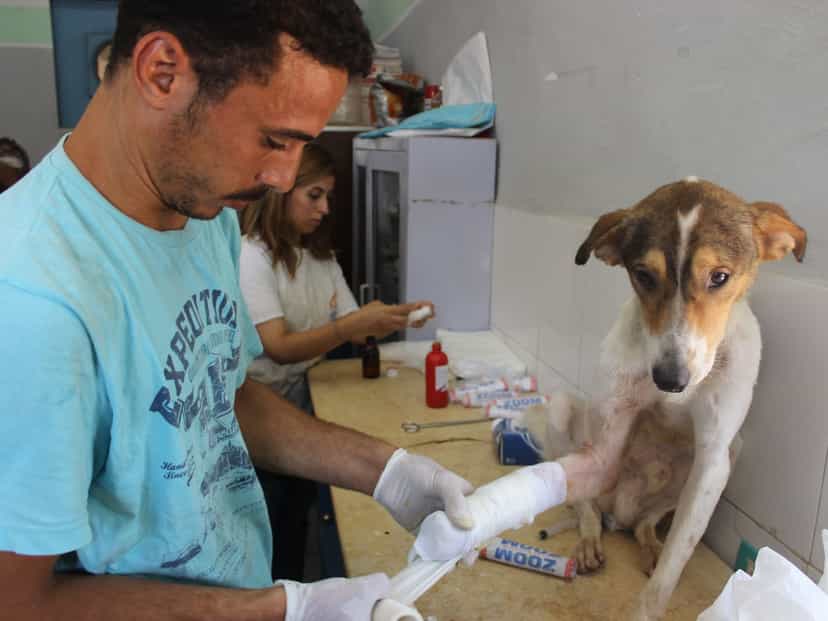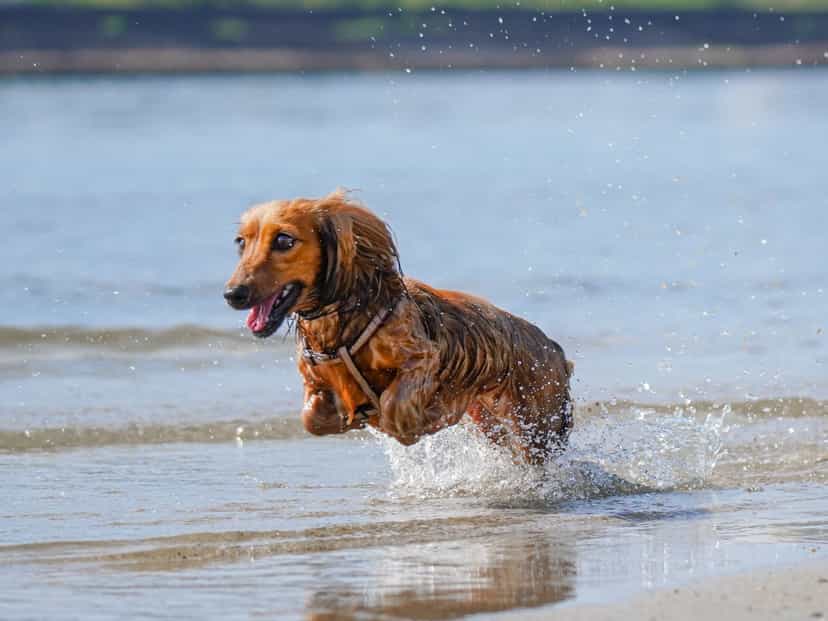
What are the symptoms of heatstroke in dogs? How can I prevent my dog from getting heatstroke? What should I do if my dog is in heatstroke? Our Dog First Aid expert Gemma answers these questions in this article.
We have already had some really hot days recently, and with more on the way I thought I should write about heat related illness in dogs.
Heatstroke is covered at length on our dog first aid courses, yet vets are still seeing the fatal effects of this condition in dogs each year.
Why?
Is it not reported on enough therefore there is a lack of education on the subject? Or do people think the condition will not affect their dog?
I aim to highlight this condition in full here and hopefully save more dogs lives.
What is Heatstroke?
Heat related illness occurs when our bodies can no longer cool us down. We all, at some point in our lives, have probably fallen foul of heat stress where we have spent a little too long in the sun and at the end of the day, we have felt a little lightheaded and dizzy, our vision might have become a little blurry and we suffer from a bit of an upset stomach. This is the very lower end of the scale when it comes to heat related illness, and it is important to stress that this is not Heatstroke.
Heatstroke is a serious medical emergency where you will start to see organ failure, low blood sugar, electrolyte problems (e.g. your potassium levels can become unstable affecting your heart which is life-threatening), and brain damage – all of which can be fatal if not treated efficiently.
First and foremost, the best piece of advice I can offer is to attend a local dog first aid course as we discuss how to perform a full body exam, and this is essential in knowing subtle signs that something is not quite right with your dog. We also talk about taking a dog’s vitals and what the normal values should be which is something every dog owner should know for their own dog. You can book a dog first aid course here Dog First Aid Training - Find a course near you! (dog-first-aid.com)

39.5°C can be a normal temperature for your dog on a hot day, but as we start to approach 40°C this can easily become heatstroke if the dog is not removed from the heat source, i.e. the garden. 40°C is not normal and we need to begin the process of cooling our dog down at this point. Cooling processes are discussed later in this article.
Heatstroke begins at 41°C, and this is where we would start to see abnormalities with the liver, kidneys, blood glucose, etc if you took a blood test.
Heatstroke is not just about overheating and is different from species to species. Not every animal or individual has the same heatstroke risk.
As we get hotter, our oxygen demands in our tissues increase therefore we need to be able to provide our tissues with extra oxygen (more than we usually do). Animals who are unable to provide their tissues with this extra oxygen that is required because they are too hot, are the animals that are at a higher risk of heatstroke.
Dogs at risk:
- Elderly dogs who do not have the extra respiratory reserve.
- Brachycephalic breeds who have smaller airways compared to their body size. As the airway naturally swells in the heat, they will be getting less oxygen into their bodies rather than more which is what is required.
- Overweight dogs – the extra weight can push on the chest and be situated around the airways making it harder for them to get more oxygen into their bodies.
- Dogs with pre-existing lung and heart conditions, as they can’t get more oxygen on board when needed, and/or they can’t efficiently transmit the oxygen around the body.
- Dogs with a lot of energy i.e young dogs. Those who love to run around – they do not have the common sense to think they are getting to hot and to stop being giddy and running around.
- Large and giant breeds with dark and/or long fur. The dark colour will absorb more heat and dense fur may act as an insulator.
What are the symptoms?
- Panting
- Increased heart rate (trying to get more oxygen into their tissues)
- Red / dark coloured gums
- Capillary Refill Time (CRT) less than 1 second
- Temperature of 41°C or above*
- Lethargic
*Once temperature reaches 41°C and organ failure occurs, they may go into shock and their temperature will then begin to drop below 41°C. Please consider the other symptoms as well.
What to do if we suspect heatstroke?
These are great tips not only for heatstroke but even for cooling your dog down if they are too hot in general!
We need to begin slowly cooling the dog down with tepid water (unless they are in shock as that is not going to help).
Never use cold or freezing water as that will constrict the blood vessels and reduce the amount of heat exchange that we are getting so it is not as effective as cool room temperature water.
Never lie a wet towel on top of the dog, EVER. This would need to be re-wet every 30 seconds to be effective otherwise it is a heating device!
Focus on a few key areas of best heat exchange with your dog:
- Paws – get their feet wet! e.g. Paddling pool.
- Armpits
- Groin
- Inner thighs
- Throat & neck area (unless the dog is stressed and struggling to breathe as this may make it worse). Otherwise, concentrate on the side of the neck and the back of the neck as this will help to cool the spine and the blood vessels in this area.
Cool the transportation to the vet down - get the air con on in the car, and plenty of ventilation before we put the dog in the car. The dog will need to visit the vet if they have been in heatstroke, even if you have cooled them down. We do not know what organ damage has been done.
At the vets, they will get the much-needed oxygen into the dog which will be super beneficial and will help to reduce the damage that has been caused. They will also put them onto a nice cool drip right into their vein, essentially cooling them from the inside.

How can we prevent it?
Avoid exercising our dogs when it is too warm. A lot of vets do not see dogs in their surgery with heatstroke on the hottest day of the year as there is some public awareness that it is too hot to take our dogs out. However, watch out for those 18°C humid and balmy days, or the ones where it is overcast but the temperature creeps up to 23°C, 24°C. Really think about your dog’s heatstroke risk as an individual - where do they fit in to the dogs who are at risk described earlier?
Even if you feel comfortable at the heat level, take into consideration that your dog is wearing a fur coat. They are the species at a higher risk of heatstroke than you.
Cooling coats and cooling mats are great if used correctly. If used incorrectly these can be very dangerous. Cooling coats are a gel-based coat that you soak with cool water, and this draws heat away from dog and into coat. The time this becomes a problem is if the coat becomes as warm as the dog and then it just becomes a heating coat which would heat the dog up, not cool them down. They should never be left unsupervised.
Cooling mats are great as the dog lies on them so it is not the same as a cooling coat, but again supervision is required especially if you had a dog that would chew the mat!
Dogs should never, ever be left in a car on warm or sunny days. Some people think that it is safe to leave a bowl of water or a cooling mat with the dog in the car and the reason this should absolutely be avoided is that it will make the atmosphere a lot more humid and muggier. This will increase the risk of heatstroke considerably.
Conservatories or kitchens with no ventilation can be just as dangerous as leaving your dog in a car so please think about where your dog is lying on a warm day.
Does your dog love to sunbathe – always monitor their time in the sun and bring them back into the cool areas.
I hope you have found this article useful and if you would like to educate yourself further by coming on a dog first aid course you can find your nearest one here Dog First Aid Training - Find a course near you! (dog-first-aid.com)



